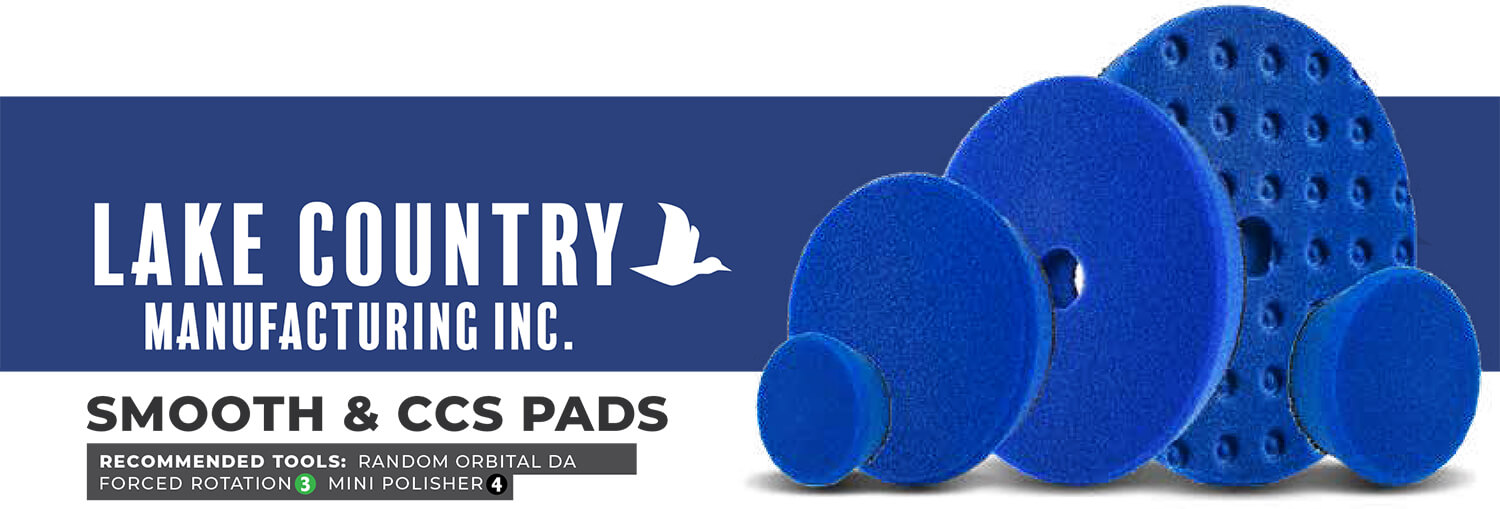I just want to know what colour/pad does what!
First tip: Don't go by the colour, the colours are not standardized, an orange pad can have different abrasion ratings even within the same brand. For example, Lake Country's own Oranges:
Hybrid Force Orange: Cutting
CCS Orange: Light Cutting
SDO/HDO Orange: Polishing
SDO & HDO Pads
SDO stands for Standard Orbital, and HDO stands for Heavy Duty Orbital. So what does it all mean? First of all, they share the same colour coordination and the same foam type, it's just that HDO pads are composed of a dual-layer system, the grey part of the foam is stiff, yet compressible, it incorporates the "Thick and Thin" design. A thinner pad is preferred on a long throw polisher (15mm, 21mm oscillation) because there's less lateral/horizontal movement. Imagine using a 2" thick pad on a 21mm throw polisher, that pad will just "Jello" around! The less unnecessary foam movement the less heat it generates and the more efficient it is for the pad to do work. But the disadvantage of using a thinner pad is that it'll have more trouble doing contour and concaves, a thicker pad just hugs body lines that much better (and helps cushion the polisher more, easier on the arms), see our Microfiber Pad FAQ page for more info on thick vs thin. So the "Thick and Thin" design allows the best of both worlds.
The SDO pad is commonly used with a short throw polisher (5mm, 8mm, 12mm's), though there's no harm going with HDO's. SDO are good all-rounders, cost less than HDOs and share the same Blue, Orange and Black Foam material.
Both SDO and HDO have an alternative CCS design (basically, dimples on the face of the foam), which we'll cover the idea of CCS in the next section.
These are not designed for rotary polishers (technically they can still be used on rotaries).
ps. the Blue HDO is one of our personal favourites, it cuts and finishes really well with 3D One.
CCS & Flat pads
Both CCS and Flat Pads uses the same foam colour and type. The chart on the right is missing Purple, Green, and Blue's. Purple is more aggressive than yellow, Green sits in between White and Black, and Blue is between Green and Black. These are supplementary pads for the user to fine-tune their cut. So it goes Purp > Yellow > Orange > White > Green > Blue > Black.
CCS: The dimples hold products better, meaning longer working time and further spread (cover larger areas), not only that, it cuts cooler and (pockets) releases polish slower without being absorbed into the pad too quickly.
Pro Tip: You can release more products from the pockets by applying more pressure when you see fit.
Technically the pad has less surface (friction) contact than Flat pads, so that also means less "pad skipping/pulling"; Rotary polisher users will know what this means, the polisher pulls you around. With the pockets, the pad will 'float' better.
Flat: More contact area. As mentioned above, CCS has reduced surface contact, meaning it's less efficient at heavy cutting and heat generation. Heat can be good or bad, if well-managed, it aids in cutting, that's actually one of the attributes of microfiber cutting pads; microfiber generates and sustains heat better than foam. But too much heat can collapse the foam structure, cause delamination, dry up polish/compound prematurely and create more compound haze. But Flats are indeed more efficient pads.
Why does heat create more compound haze? Heat softens paint, and grit can dig into it and cut more than it's supposed to.
Hybrid Force Pads
"Force" stands for Forced rotation polishers such as Rotary or Forced rotation polishers (Flex XCE, Rupes Mille).
These pads are generally slightly thicker than DA (dual action) pads, for example, 1-1/4" vs 7/8". The extra thickness allows the pad to cushion the rotary's power better, and also allows the users to tilt the machine more; imagine the difficulty of tilting a microfiber disc vs a thicker foam pad.
If you look closely (for the 3", 5", 6" pads), they have a 'rounded' tapered edge; the taper is not as 'sharp' as the DA pads, these are slightly rounded, meaning you'll be able to tilt your polisher and polish with the rounded edge, really useful for isolating scratches. Instead of polishing and reducing clearcoat on the entire 6" surface just to take a small scratch out, rotary polishers allow more pinpoint accuracy in isolating defects.
The Grey is the most aggressive foam offering (though there's a Blue Wool, but we'll cover that in another blog). When the pad is new, it's fairly stiff and what you'll notice is it'll 'skip' on panels. To remedy this, wet the Grey pad slightly more than normal, and as you work the pad in, it'll soften over time.
Waffle Pad
Think of Waffle Pads as a more aggressive form of CCS pads (with big pockets). These are likely the easiest pad to work with but the slowest at cutting. Imagine pressing a waffle pad flat against a surface, only the peaks of the waffle will be in contact with the surface and not the troughs. Meaning, a 5" pad is technically only 2.5" in terms of surface contact. Of course, this will depend on how aggressively the peaks and troughs are in the pad design and the surface profile (concaves or contours) you're working on.
1. It generates very little heat. This in turn won't dry up the polish too quickly and increases working time and area. Recommended in hot/dry summers.
2. Low surface contact and heat mean slower cutting.
3. Pad glides easily on panels. Your polisher won't "pull you around".
4. The ability to release more products with pressure; the polish liquids can be placed in the troughs of the pad, and releasing it onto the surface as you polish. Can do that with CCS pads also.
5. Yvan Lacroix swears by them😆

So, I have an "X" polisher, just tell me what I need to use!
All the above are rotary or forced rotation polishers, so:
Best: Hybrid Force Pads, Wool Pads (we'll talk about wool pads in another article).
Good: Waffle, CCS (these pads with reduced surface area help the pad float better on panels).
Bad: Thinner pads in general, such as microfiber.
More Quick Posts📖
Shinemate EX620 All you need to know.
Rupes Killer? Sort of. Not quite. Well, maybe. A forced-rotation-like DA polisher that hangs with the best at an entry-level price.
To Graphene or not to Graphene?
To Graphene or not to Graphene? We get asked this a lot. Graphene & Traditional Ceramic Coatings.










